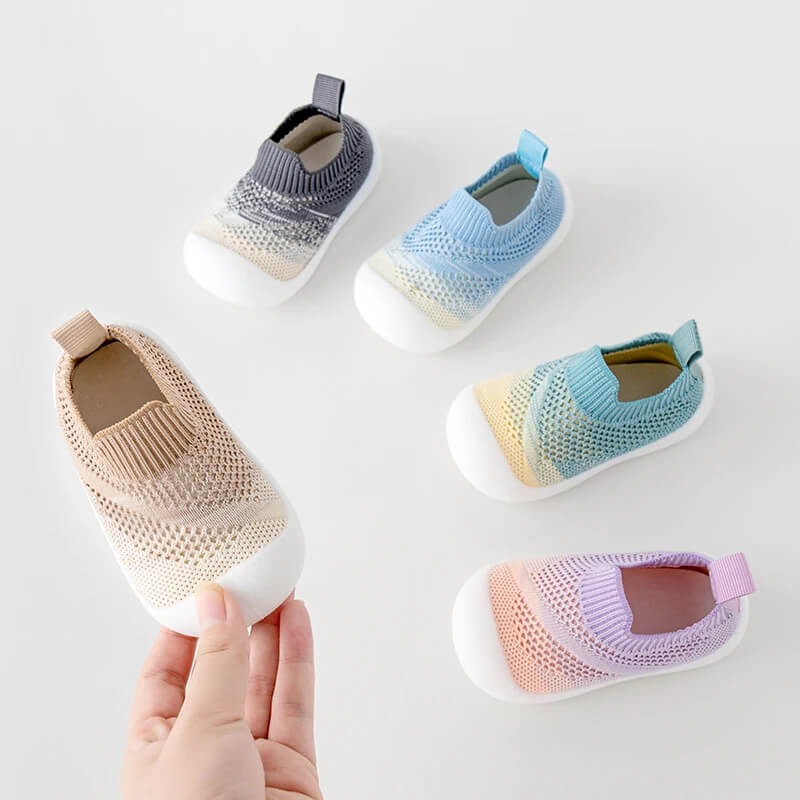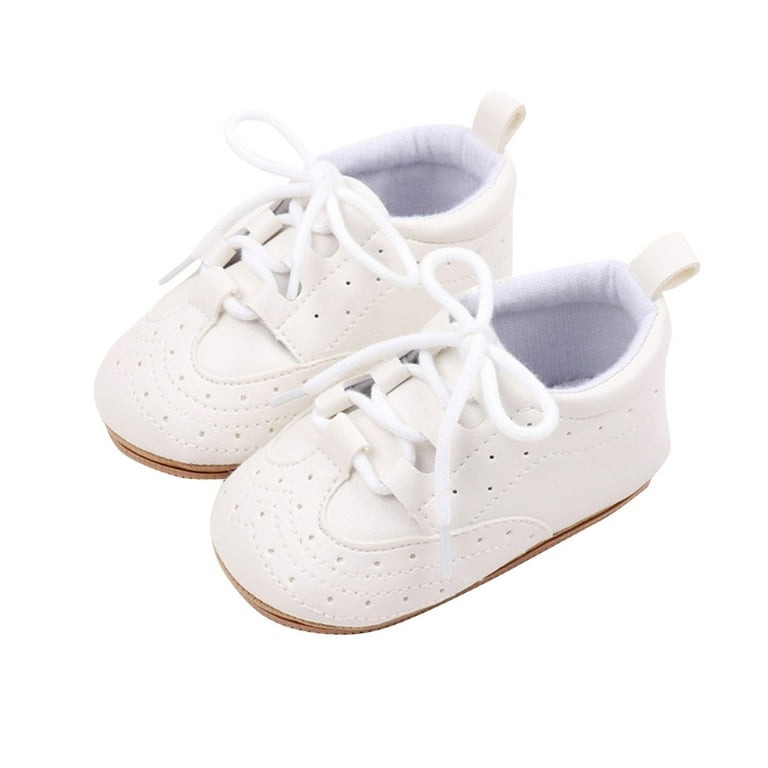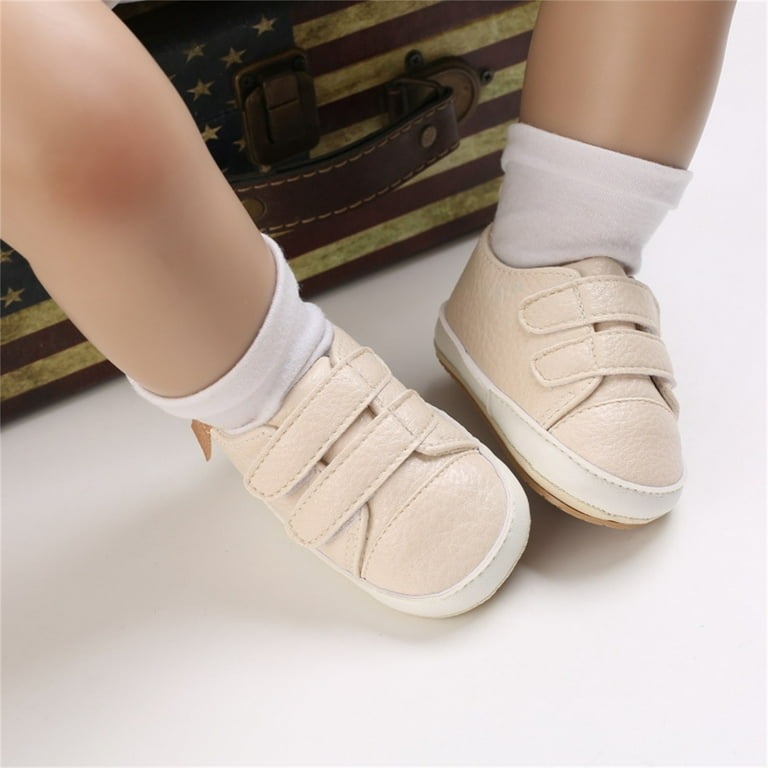Importance of Selecting the Right First Walker Shoes
Selecting the right first walker baby shoes is crucial. Their first steps mark a milestone. Proper shoes support these pivotal moments. They provide stability and confidence as your baby learns to walk. First walker shoes should be more than cute. They must ensure safety and foster natural foot development. Good shoes can prevent falls and injuries. They help in promoting correct walking patterns. Ill-fitting or hard-soled shoes can hinder walking skills. They might even cause foot problems later on. A great pair of first walker shoes balances comfort, fit, and support. They make your baby’s transition to walking smooth and safe. Always choose shoes designed with a baby’s foot growth in mind. In summary, the right shoes impact your baby’s walking journey. They can set a strong foundation for healthy foot development.
Key Features to Look for in First Walker Shoes
When shopping for first walker baby shoes, focus on certain features. These will ensure your child’s feet are well-supported and comfortable. Here’s what to consider:
Flexible Soles: Soft, flexible soles mimic barefoot walking. This helps in strengthening your baby’s foot muscles and arches.
Breathable Materials: Shoes made from breathable materials keep feet dry and healthy. They prevent overheating and fungal infections.
Room to Grow: Look for shoes with some extra space. Babies’ feet grow quickly. A little extra room means the shoes will last longer.
Lightweight Construction: Heavy shoes can trip up tiny feet. Choose lighter shoes that won’t weigh down your child’s steps.
Adjustable Fastenings: Velcro or lace-up options give a secure fit. They can be adjusted as your baby’s feet grow.
Padded Ankles: Padding supports and protects the ankles. It helps prevent any wobbling as your child walks.
Non-Skid Soles: A strong grip reduces slips and falls. Look for textured or non-skid soles for safety.
Proper Fit: Good shoes fit well. They shouldn’t pinch or leave marks. Always check the fit in store or follow online measuring guides.
Incorporating these features into your selection process will help you find the best first walker baby shoes. Keep in mind that your baby’s comfort and foot health are paramount. The correct shoes can make the first steps joyful and secure.
Understanding Foot Development and Shoe Fit for Babies

As babies grow, their feet need special care. From soft bones to unique shapes, baby feet change fast. They are not just small adult feet. Babies’ feet develop quickly in the first years of life. This growth requires shoes that can adapt and protect.
Here’s what you should know about foot development and shoe fit:
- Soft Bone Structure: A baby’s foot is made up of soft bones. These bones need room to grow and harden without pressure. Tight shoes can alter foot growth. Choose shoes that allow for natural foot movement.
- Arch Development: Infant feet appear flat because their arches are not yet developed. It’s important to have shoes that are not restricting this natural process. Opt for shoes with flexible soles that mimic barefoot walking.
- Toe Wiggle Room: Toddlers need space to wiggle their toes. Enough room at the front of the shoe is essential for healthy development.
- Heel Fit: Shoes should not be too tight or too loose on the heel. The correct fit keeps the shoe in place. It prevents unnecessary rubbing that can lead to blisters.
- Periodic Assessment: Regularly check the fit of your baby’s shoes. Kids’ feet grow unexpectedly fast. Shoes that fit one month may not fit the next.
- Natural Materials: Choose shoes made with natural materials. They adapt to the shape of the baby’s foot. They also help prevent sweat buildup, keeping feet dry.
A good fit in first walker baby shoes will support and protect your baby’s feet. It will not restrict growth or cause discomfort. Watch how your child walks in the shoes. Make sure the shoes help them walk naturally and with confidence. Baby shoes should aid in their development, not hinder it. Always consider the ongoing changes in your baby’s feet when purchasing first walker baby shoes.
Materials and Design: Safety and Comfort First
When picking first walker baby shoes, materials and design matter. Safety and comfort should lead your choices. Remember, a baby’s skin is sensitive and demands soft materials. Avoid hard textures that can irritate or harm their feet.
For the upper part of the shoe, select natural fabrics like leather or cotton. These adapt to the foot’s shape and allow for breathability. This minimizes sweat buildup and prevents rashes or infections.
Ensure the insole is comfortable and made of a cushioned material. This will support your baby’s foot without restricting movement. A cushioned insole can also absorb shock and add to the stability of the shoe.
Look for non-toxic materials. Babies often put their feet in their mouths. Make sure all materials used are safe for such behavior.
The shoe’s design should feature a wide toe box. This gives toes enough room to move freely. A wide toe box aids in balance and supports natural foot growth.
Choose shoes with a flexible, non-skid sole. Such a sole provides grip and promotes confidence with each step. Ensure the sole is also thin enough to let your baby feel the ground.
For the shoe’s closure, opt for adjustable fastenings like Velcro or laces. These allow you to fit the shoe snugly as your baby’s feet grow.
Always consider how the materials and design will affect your baby’s comfort and safety. It ensures they can explore the world around them with joy and ease. Keep the focus on creating a positive walking experience for your baby.
When to Introduce First Walker Shoes
Knowing the right time to introduce first walker baby shoes is essential for your child’s development. The timing varies from baby to baby as they reach walking milestones at their own pace. Usually, first walker shoes become necessary when your baby starts to take independent steps. This developmental stage typically occurs between 9 to 18 months. Before this, bare feet or non-restrictive socks are best. They allow toes to grip and muscles to develop.
When your baby begins cruising, holding onto furniture for balance, it’s time to think about proper footwear. If your little one shows interest in walking outdoors, it’s a clear sign for first walker shoes. They will protect their feet from rough surfaces and the elements.
Always observe your baby’s comfort level with shoes. Start with short periods of wear indoors. This helps them get used to the sensation of shoes on their feet. Gradually increase the time as they become more confident walkers. Remember, shoes should be an aid in walking, not a hindrance. So, make sure to introduce them at a time when your baby is ready to explore walking further.
In conclusion, the best time for first walker baby shoes is when your baby actively takes steps and needs protection outside the home. Invest in the right pair as discussed earlier in the blog, keeping in mind the key features for comfort and support. Watch for signs of readiness and ensure the shoe introduction enhances their walking experience.
Popular Brands and Styles for Baby’s First Shoes

Choosing the right brand and style for your baby’s first walker shoes is important. Brands that specialize in baby footwear often consider the developmental and health aspects we’ve discussed. Let’s highlight some popular brands and styles that are often recommended for babies taking their first steps.
Soft Sole Shoes: Brands such as Robeez and Pediped offer shoes with soft soles. These are ideal for mimicking barefoot walking, which helps in the foot development process.
Adjustable Shoes: Stride Rite and Bobux are known for their adjustable fastenings. This ensures a snug fit as your baby’s feet grow, and they come in various styles for both boys and girls.
Eco-Friendly Options: If you prefer eco-friendly shoes, Seekairun and Livie & Luca use non-toxic, sustainable materials. They also prioritize flexibility and comfort in their design.
Fashion-Forward Styles: For style-conscious parents, brands like Converse and Vans have mini versions of their classic shoes. These can be a stylish addition to your baby’s wardrobe, but always put comfort first.
Outdoor-Ready Shoes: For the adventurous baby, brands like Keen and Merrell offer durable, protective shoes. These are great for outdoor activities, with traction to handle different terrains.
When choosing a brand or style, remember to prioritize the key features of first walker baby shoes. Look for flexibility, breathable materials, and room for growth to ensure your baby steps out in both style and comfort. Consider your baby’s individual needs and where they will wear the shoes to pick the best option. Each baby is unique, so what works for one may not be perfect for another.
Caring for Your Baby’s First Walker Shoes
Caring for your baby’s first walker shoes is key to their longevity. Proper care ensures they remain supportive and safe as your baby continues to explore walking. Below are some care tips to keep in mind:
Regular Cleaning: Wipe shoes with a damp cloth to remove dirt. Use a gentle cleaner suitable for the shoe material. Allow shoes to air dry; avoid direct heat that might warp the materials.
Deodorizing: Keep shoes smelling fresh with natural deodorizers. Baking soda, for example, can be sprinkled inside overnight, then shaken out in the morning.
Moisture Control: If shoes get wet, stuff them with newspaper to absorb moisture. Replace the paper as needed until the shoes are dry.
Storage: Store shoes in a cool, dry place when not in use. This prevents materials from deteriorating due to humidity or heat.
Rotation: If possible, rotate between different pairs of shoes. This allows each pair to air out, reducing wear and tear.
Inspection: Check shoes regularly for signs of wear. Look for tears, detached soles, or worn-out insoles. Replace shoes as needed to maintain foot support and safety.
Following these simple steps will help maintain your baby’s first walker shoes. This ensures a comfortable and secure walking experience every time they step out to explore.
Tips for Shopping for Baby’s First Shoes

When embarking on buying your baby’s first walker shoes, a few tips can guide you to make the best choices. Here is what you should keep in mind:
- Measure Regularly: Babies’ feet grow quickly. Measure their feet every few weeks to ensure a proper fit.
- Shop Later in the Day: Feet can swell during the day. Fit shoes when your baby’s feet are at their largest.
- Check Return Policies: Kids can be unpredictable. Buy from stores that allow returns if shoes don’t fit right or your baby doesn’t like them.
- Seek Professional Help: If possible, have your baby’s feet measured by a professional to find the correct size.
- Prioritize Comfort Over Style: Always choose comfort and support over aesthetics. Your baby’s foot health comes first.
- Test Walks: Let your baby walk around in the store with the shoes. Watch for any signs of discomfort or poor fit.
- Buy for Now: Don’t buy shoes to grow into. Oversized shoes can be unsafe for a baby learning to walk.
By following these tips, you increase the likelihood of purchasing first walker baby shoes that are comfortable, fit well, and support your baby’s foot development. Happy shopping!